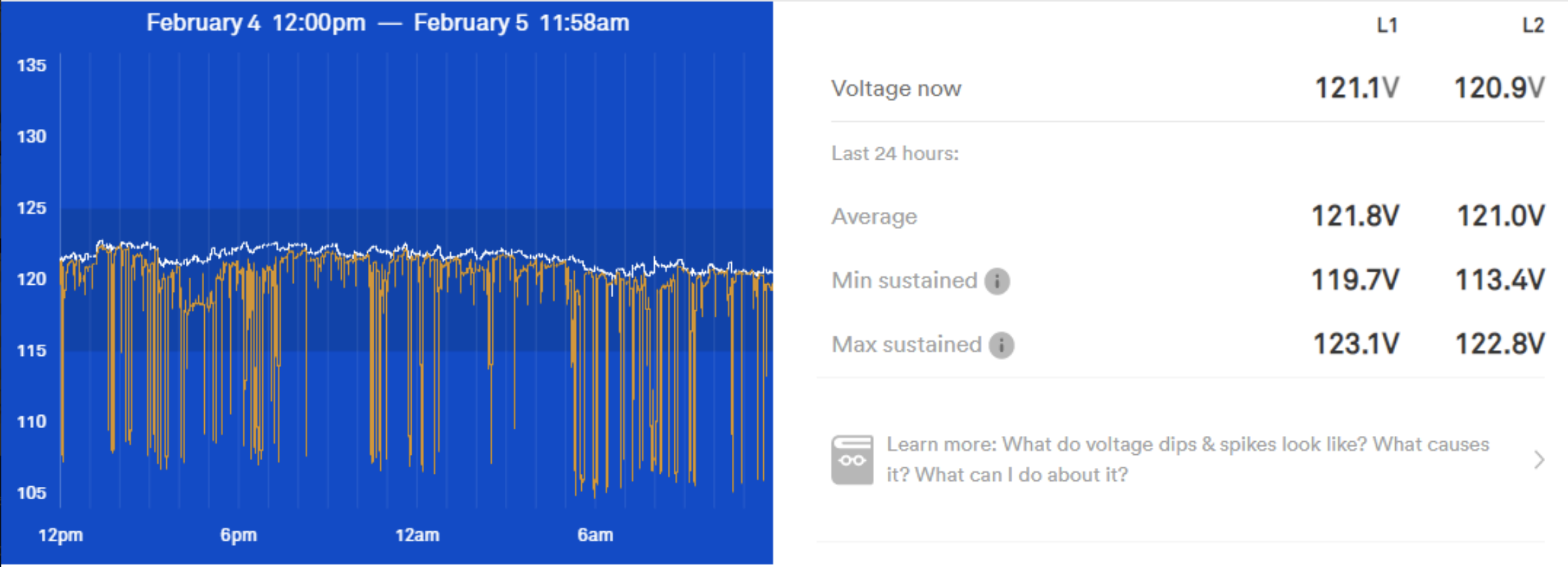Sense is a great way to monitor your home’s electricity usage, but did you know that you can also use it to make your home safer? We combed through our favorite Sense features and stories to share our top 5 safety tips that can give you peace of mind when you’re at home or traveling.
1. Find out if your Power Quality is safe
In Sense Labs, you can see your home’s Power Quality. In a typical residential electrical panel, each of the two main phases should sustain a voltage of about 120V. But if there’s a problem with the power quality of the electricity from the utility or your electrical panel needs repair, those phases can get out of whack, which can create a fire risk.
The Power Quality project provides live voltage readings from both legs as well as a graph of voltage for the last 24 hours. Power Quality also shows dips and spikes in voltage outside of a normal range with a 24-hour graph view of both legs.
Sense users have been able to use Power Quality to identify major issues, from floating neutrals to a loose breaker that was causing arcing. You can see a list below of the issues that Sense users have been able to confirm in our Community with their original screenshots from the Sense app.
• Undersized Transformer
• Transformer Upgrade
• Substation Tap Changer
• Water Corrosion in Panel
• Loose Neutral in Panel
• Arcing Panel
• Failing Phase in Panel
• Transformer Issue
• Solar Inverter Error
• Neighbor’s Faulty AC
• Fault Connection at Pole
• Floating Neutral at Street
2. Set alerts to tell you if things stay on too long or don’t turn on at all
Have you ever left your home and had the panic-inducing thought, “Did I leave the stove on?” Sense can help. Once Sense has detected a device, you can create notifications to alert you when the appliance is off or on for a specific period of time.
For instance, one Sense user set up a custom notification to alert him if the hot water heater for his in-floor heating system failed to turn on within 8 hours. Soon after setting up the notification, he received an alert. Because the issue was caught so quickly, the water in the tank was still above 140 degrees Fahrenheit. He was able to contact the local plumbing supplier the next day, who then came to replace a failed controller before the hydronic in-floor heating lines could drop below 75 degrees Fahrenheit or even into the freezing range, which could damage the in-floor system.
If you have a crucial device that Sense has not detected, you can use our smart plug integration to track it and alert you if your device is on or off for an extended period of time, then control the device.
3. Detect devices that are starting to fail
With Sense, you get to know the typical behavior of a device in the Power Meter and Device views. How often does it turn on? What’s the average running wattage? Once a device is beginning to fail, its patterns change, making it possible to identify potential failures. For instance, a user discovered a broken capacitor in his subwoofer and another user discovered a hornet’s nest was causing his AC to stop blowing cold air.
A Sense Labs project called Motor Stalls is able to identify when devices with large motors are trying repeatedly to start, and it is a great first place to start when checking on the health of large appliances. Some Sense users have been able to avoid costly repairs with data provided by Sense, like the user who was able to fix his heat pump by replacing the start capacitor without the need for additional repairs or charges.
4. Get alerts when critical appliances are running too often or not at all
Many homes have critical appliances like well pumps, water heaters, heating systems and sump pumps that provide essential services. For these devices, it’s imperative to make sure they’re operating (or not operating) at the appropriate time. One user noticed that his well pump was running too frequently and used Sense to identify an issue with the relay control switch — potentially avoiding a pump replacement.
Another Sense user was driving when she got a Sense notification that her home’s electricity had exceeded a daily threshold. She called her nephew, who checked on her house and confirmed that the water was left on, forcing the well pump to run non-stop. Problem averted!
Sense can also be used to alert you that a sump pump has turned on, telling you that there could be a potential flooding problem to investigate.
5. Spy on your home while away
After you leave your house, use the Sense app to check in on the last 24 hours of activity so you have a reference for the rest of your trip in case things turn on or off. Look in the Power Meter view to see when usage peaks. Set an alert to tell you if your energy exceeds that peak – which can tell you if anything unusual has turned on in your home!
If you have someone coming over to feed your dog or water a plant, you can check to make sure they didn’t accidentally leave something on by seeing if your power usage has increased past its typical baseline. You could even put a Philips Hue light bulb near each of your entrances and set an alert in the Sense app so you know if anyone has entered the home and turned on lights.

